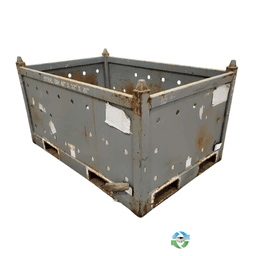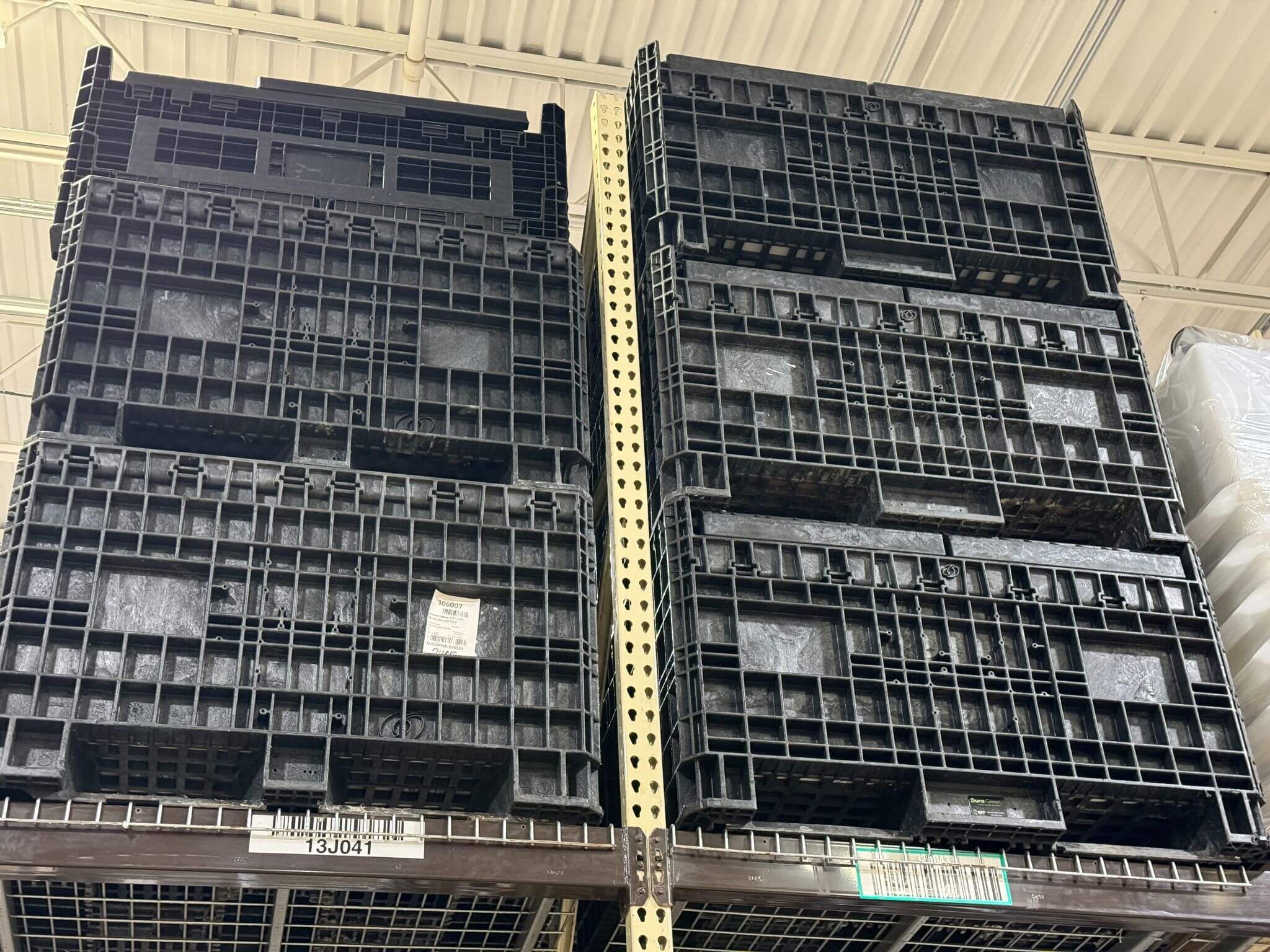The Ultimate Guide to Picking the Right Bulk Containers for Your Business Requirements
Picking the suitable bulk containers is critical for any service that counts on effective logistics. Various types of containers exist, each created for specific products and applications. Elements such as size, material compatibility, and regulatory criteria play a considerable function in this decision-making procedure. Understanding these aspects can result in boosted functional performance. Lots of organizations overlook crucial facets that might enhance their general performance and sustainability. What are these considerations?
Recognizing Various Types of Bulk Containers
Mass containers function as essential tools for businesses seeking reliable storage space and transportation options. These containers can be found in different types, each designed to satisfy specific operational needs. One usual kind is the intermediate bulk container (IBC), which is perfect for liquid and granulated products, providing a balance of capability and maneuverability. An additional preferred option is the mass bag, or FIBC, appropriate for completely dry, flowable items. These flexible containers are light-weight and can be easily delivered and saved. For much heavier products, stiff bulk containers are commonly utilized, providing resilience and stability for risk-free handling. Furthermore, there are specialized containers customized for dangerous products, ensuring conformity with safety policies. Comprehending the distinct features of these bulk container kinds enables businesses to make informed decisions that optimize logistics and reduce expenses. By selecting the ideal container, firms can improve their functional effectiveness and improve their supply chain procedures.
Key Product Factors To Consider for Mass Containers
When picking mass containers, it is vital to contemplate the products used in their building and construction. Elements such as chemical, toughness, and stamina compatibility play a critical role in making certain the containers satisfy particular operational needs. In addition, weight and portability issues can influence both performance and transportation logistics.
Material Resilience and Strength
Sturdiness and toughness are crucial consider choosing materials for mass containers, as they directly influence the container's ability to stand up to various environmental problems and handling processes. Materials such as high-density polyethylene (HDPE), polypropylene, and stainless-steel are commonly preferred for their robust residential properties, providing resistance to abrasion, impact, and temperature level changes. The choice of material likewise impacts the overall life-span of the container; stronger products generally lead to much less frequent substitutes, causing cost financial savings over time. Furthermore, the weight of the material can impact delivery costs and ease of handling. Companies must consider their specific operational settings and the potential for wear and tear to ensure peak sturdiness and strength in their bulk container option.
Chemical Compatibility Variables
Understanding chemical compatibility is vital for selecting mass containers, as the products made use of must stand up to the certain compounds they will hold. Various factors influence compatibility, including the chemical nature of the components, temperature level, and period of storage space. As an example, destructive chemicals might require containers made from stainless steel or specialized plastics that resist degradation. Additionally, reactive compounds can create heat or gases, requiring aired vent or pressure-rated containers. The choice of container material, whether metal, polycarbonate, or polyethylene, should line up with the chemical buildings of the stored compounds to avoid leakages or violations. Ultimately, a thorough analysis of these compatibility elements assures safe handling and storage, protecting both personnel and the environment while preserving product honesty.
Weight and Transportability Worries
Choosing bulk containers entails not only evaluating chemical compatibility but additionally taking into consideration weight and transportability. Businesses should evaluate the simplicity of handling and transportation to optimize effectiveness. Light-weight products like high-density polyethylene (HDPE) or light weight aluminum can help with much easier movement and decrease shipping costs. Alternatively, heavier containers may offer enhanced durability but can impede movement, especially in environments requiring regular moving. Furthermore, the layout of the container must permit convenient lifting and stacking, making certain ergonomic safety and security for employees. Companies must likewise consider the facilities available for transportation; for example, containers compatible with forklifts or pallet jacks can improve procedures. Inevitably, the ideal equilibrium in between weight and transportability straight influences functional performance and price efficiency.
Sizing Your Bulk Containers for Ideal Performance
When sizing bulk containers, businesses should very carefully analyze the dimensions required to suit their specific products. In addition, weight capacity is an important factor that influences efficiency and safety and security during transportation and storage. Efficient sizing not only takes full advantage of area but additionally enhances operational operations.
Establishing Container Dimensions
Picking the best measurements for bulk containers is vital for maximizing performance in storage space and transportation. Services must analyze their details demands, taking right into account factors such as available space, the nature of the goods being stored, and the methods of transport utilized. Precise measurements guarantee that containers fit ideally in automobiles and warehouses, minimizing lost area and decreasing handling time. Criterion dimensions can use convenience, however customized dimensions may be essential for unique demands or to accommodate specific items. In addition, it is necessary to review piling capabilities and ease of access, as these variables affect total functional effectiveness. Ultimately, the ideal measurements cause improved organization and streamlined logistics, benefiting the general performance of business.
Weight Ability Considerations
Recognizing weight ability is essential for businesses aiming to optimize their mass container efficiency. The weight ability of a container straight influences storage space capacities, transport logistics, and overall functional costs. Picking containers with the suitable weight limitations assures that organizations can safely store and transport their products without risking damage or conformity problems. Straining containers can result in structural failings, while underutilizing capacity lead to thrown away resources. When picking containers, it is important for businesses to assess their product weights and consider any regulatory requirements. Furthermore, aspects such as the sort of product, planned use, and ecological problems should also influence weight capability decisions. By reviewing these components, organizations can enhance efficiency and ensure a streamlined supply chain.
Regulatory Conformity and Safety Requirements

Governing conformity and safety and security criteria play a crucial function in the selection of mass containers for businesses. Organizations should guarantee that their containers fulfill numerous laws established by neighborhood, nationwide, and international authorities. These requirements often concern material security, architectural honesty, and correct labeling, which aid protect against crashes and ensure the risk-free transportation of products.
In addition, adherence to industry-specific standards, such as those from the Fda (FDA) or the Occupational Safety and Health And Wellness Administration page (OSHA), is crucial for business dealing with hazardous view it now materials or food products. Non-compliance can result in fines, lawful concerns, or damages to a business's track record.
Services need to additionally think about the container's compatibility with the materials being stored or moved to prevent contamination or chain reaction (used bulk containers). To summarize, understanding and carrying out governing compliance and safety criteria is important for the liable and effective usage of mass containers
Sustainability Choices for Eco-Friendly Bulk Containers

Companies are also exploring options made from recycled materials, which not only preserve sources yet likewise support the reusing market. Developments in layout enable for lighter containers that need much less energy to transportation, even more enhancing sustainability. By incorporating these environmentally friendly bulk container options, organizations can show their dedication to ecological stewardship while meeting consumer need for sustainable methods. This change not just helps the planet yet can also boost brand name online reputation and consumer commitment.
Cost-Effectiveness and Budgeting for Mass Containers
While numerous businesses concentrate on sustainability, cost-effectiveness continues to be a critical factor when selecting bulk containers. Organizations has to assess the first acquisition price, as well as long-lasting functional costs, to ensure economic practicality. Elements such as upkeep, sturdiness, and reusability play a substantial duty in establishing general costs.
Purchasing top notch containers might yield greater upfront prices yet can result in savings with decreased substitute rates and lowered waste. Additionally, organizations ought to think about transportation expenses and storage space performance, as these can impact the total spending plan.

Frequently Asked Inquiries
Just how Do I Establish the Right Container for Hazardous Materials?
To figure out the ideal container for dangerous materials, one have to examine compatibility visit here with the compound, consider the container's material, check for regulative compliance, and examine capability and safety attributes to assure correct handling and storage space.
Can Bulk Containers Be Personalized for Particular Products?
Yes, bulk containers can be personalized for particular products. refurbished bulk containers. Different attributes, such as material, layout, and dimension, can be tailored to satisfy unique demands, making sure suitable safety and efficiency for delivering and saving different products
What Is the Typical Life Expectancy of Various Mass Container Types?
The ordinary life expectancy of bulk container types varies; plastic containers last 5-10 years, metal containers 10-20 years, and wooden containers generally last 3-7 years, depending on usage, maintenance, and ecological problems.
How Should I Tidy and Maintain Mass Containers?
To cleanse and maintain bulk containers, one ought to routinely inspect for damages, eliminate deposit, clean with appropriate detergents, wash thoroughly, and warranty appropriate drying before storage space. Adhering to manufacturer guidelines boosts longevity and safety and security throughout use.
Exist Rental Alternatives for Mass Containers Available?
Yes, numerous firms supply rental options for bulk containers, giving adaptability for services. These services can accommodate various needs, allowing business to handle inventory efficiently without the commitment of buying containers outright.
Sturdiness and toughness are essential factors in choosing materials for mass containers, as they directly influence the container's capacity to endure different ecological problems and taking care of procedures. Recognizing chemical compatibility is essential for selecting mass containers, as the materials utilized need to withstand the specific materials they will certainly hold. Understanding weight capacity is vital for services aiming to maximize their mass container efficiency. Regulatory conformity and safety criteria play a crucial function in the option of bulk containers for organizations. While numerous companies focus on sustainability, cost-effectiveness continues to be a critical variable when choosing bulk containers.